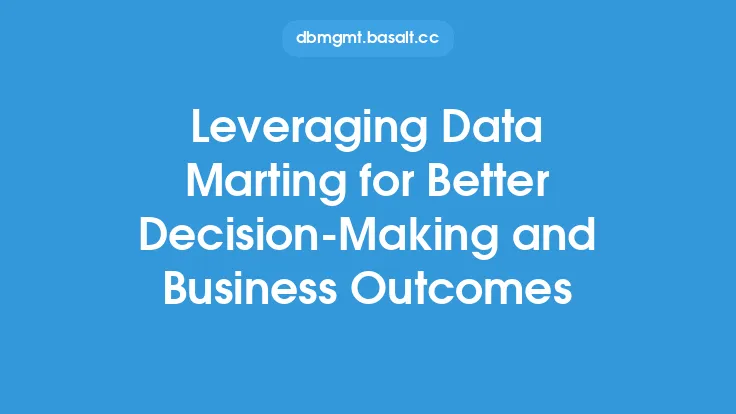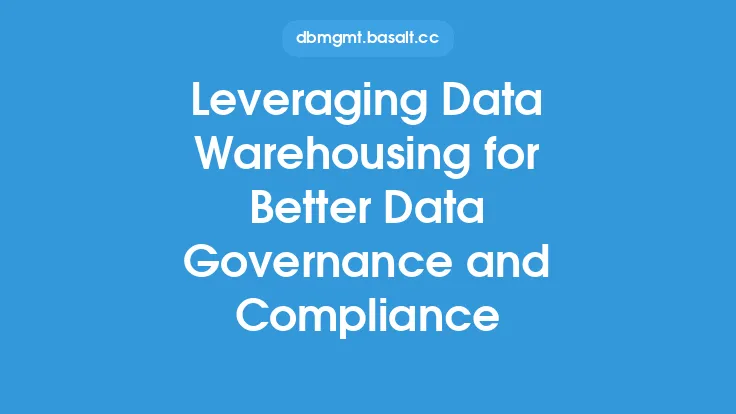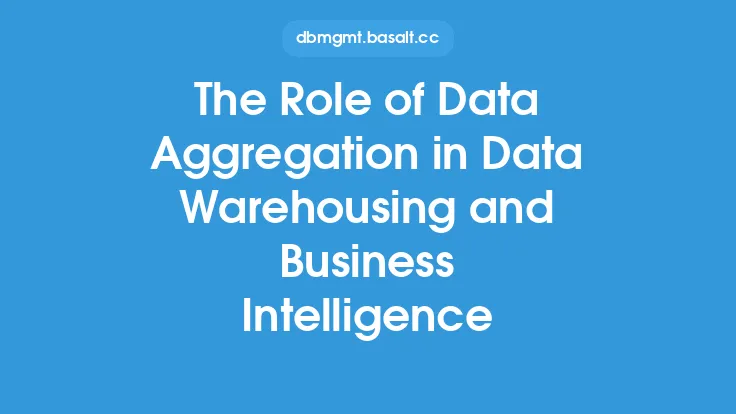In today's data-driven business landscape, organizations are constantly seeking ways to gain a competitive edge by making informed decisions based on accurate and timely insights. One crucial aspect of achieving this goal is the effective use of data aggregation, a process that involves collecting and combining data from multiple sources into a single, unified view. By leveraging data aggregation, businesses can unlock the full potential of their data, gain deeper insights, and make better decisions. In this article, we will delve into the world of data aggregation, exploring its benefits, techniques, and applications in the context of business intelligence.
Introduction to Data Aggregation
Data aggregation is a fundamental concept in data analysis and business intelligence, referring to the process of gathering and combining data from multiple sources, such as databases, spreadsheets, or external data providers. The primary objective of data aggregation is to provide a unified view of the data, enabling organizations to analyze and understand complex relationships, trends, and patterns. By aggregating data, businesses can reduce data complexity, improve data quality, and increase the accuracy of their insights.
Benefits of Data Aggregation
The benefits of data aggregation are numerous and significant. Some of the most notable advantages include:
- Improved data quality: Data aggregation helps to eliminate data inconsistencies, errors, and redundancies, resulting in higher-quality data that is more reliable and trustworthy.
- Enhanced data analysis: By combining data from multiple sources, organizations can perform more comprehensive and nuanced analysis, revealing insights that might be hidden in individual data sets.
- Increased efficiency: Data aggregation automates the process of collecting and combining data, reducing manual effort and minimizing the risk of human error.
- Better decision-making: With a unified view of their data, organizations can make more informed decisions, driven by accurate and timely insights.
Data Aggregation Techniques
There are several data aggregation techniques that organizations can use, depending on their specific needs and goals. Some common techniques include:
- Roll-up aggregation: This involves aggregating data from multiple sources into a single, higher-level summary.
- Drill-down aggregation: This technique enables users to drill down into detailed data from a higher-level summary.
- Grouping aggregation: This involves grouping data by specific attributes or categories, such as customer demographics or sales regions.
- Data warehousing: This technique involves creating a centralized repository of aggregated data, providing a single source of truth for business intelligence and analysis.
Data Aggregation Tools and Technologies
A range of tools and technologies are available to support data aggregation, including:
- Data integration platforms: These platforms provide a unified interface for collecting, transforming, and loading data from multiple sources.
- Data warehousing solutions: These solutions provide a centralized repository for aggregated data, supporting business intelligence and analysis.
- Business intelligence tools: These tools enable users to analyze and visualize aggregated data, providing insights and recommendations.
- Cloud-based data aggregation services: These services provide scalable, on-demand data aggregation capabilities, supporting real-time data processing and analysis.
Applications of Data Aggregation
Data aggregation has a wide range of applications in business intelligence, including:
- Sales and marketing analysis: Data aggregation enables organizations to analyze sales trends, customer behavior, and market dynamics.
- Financial analysis: Data aggregation supports financial analysis, enabling organizations to track revenue, expenses, and profitability.
- Operational analysis: Data aggregation helps organizations to analyze operational performance, including supply chain management, inventory control, and logistics.
- Customer relationship management: Data aggregation enables organizations to analyze customer behavior, preferences, and demographics, supporting targeted marketing and customer engagement strategies.
Challenges and Limitations of Data Aggregation
While data aggregation offers numerous benefits, there are also challenges and limitations to consider. Some of the most significant challenges include:
- Data quality issues: Poor data quality can compromise the accuracy and reliability of aggregated data.
- Data security and governance: Data aggregation requires robust security and governance measures to protect sensitive data and ensure compliance with regulatory requirements.
- Scalability and performance: Data aggregation can be resource-intensive, requiring scalable and high-performance infrastructure to support large-scale data processing.
- Data complexity: Data aggregation can introduce complexity, particularly when dealing with diverse data sources, formats, and structures.
Best Practices for Data Aggregation
To overcome the challenges and limitations of data aggregation, organizations should follow best practices, including:
- Establishing clear data governance policies and procedures.
- Implementing robust data quality control measures.
- Selecting scalable and high-performance data aggregation tools and technologies.
- Providing training and support for users to ensure effective use of aggregated data.
- Continuously monitoring and evaluating data aggregation processes to ensure accuracy, reliability, and efficiency.
Conclusion
In conclusion, data aggregation is a powerful technique for unlocking the full potential of business data, providing a unified view of complex relationships, trends, and patterns. By leveraging data aggregation, organizations can gain deeper insights, make better decisions, and drive business success. While there are challenges and limitations to consider, following best practices and selecting the right tools and technologies can help organizations to overcome these hurdles and achieve their goals. As the volume and complexity of business data continue to grow, the importance of data aggregation will only continue to increase, making it an essential component of any business intelligence strategy.





